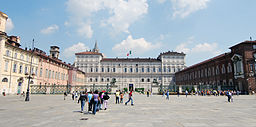
Turin
Turin is a large city in northwestern Italy, and is the fourth largest city on the Apennine Peninsula in terms of population. The city itself has a permanent population of about 910,000, but if we add the surrounding agglomeration, it is more than 1.7 million inhabitants.
The local palaces have been a UNESCO World Heritage Site since 1997.
It is a very important industrial centre within the region and, among other things, it is home to fiat. It is also an important educational, cultural and sports centre of the whole area. Many still remember the year 2006, when the Winter Olympics were held in Turin.
Sights of Turin
In Turin there are a lot of attractions and monuments to see, not the tour of which will definitely not be enough for just one day. So if you will be in the city only for a short time, you have to choose what is your priority and what you want to visit preferentially.
Palazzo Reale – a beautiful royal palace, the construction of which dates back to 1646–1658. It also includes beautiful gardens and a highly sought-after royal armoury.
Cathedral – was built in 1491–1498 in a beautiful and typical Renaissance style.
Palazzo Madama – this palace was a castle in the thirteenth century, which was expanded and rebuilt in the fifteenth century. Directly in the palace there is an art museum.
Palazzo dell’Academia delle Scienze – an interesting Baroque building from the seventeenth century, in which you can visit the museum of egyptian art collections. Many experts consider this Egyptian exposition to be the most important after Cairo and London.
Palazzo Carignano – the most important Baroque monument in the city. It was built between 1679 and 1684 and for a long time housed the Italian Parliament.
Subdivisions of Turin
Like other cities, Turin is divided into smaller territorial units. This will make orientation in the city easier and is also important for the city administration. In the case of Turin, there are eight quarters, they are:
- Circoscrizione 1: Centro – Crocetta
- Circoscrizione 2: Santa Rita – Mirafiori Nord – Mirafiori Sud
- Circoscrizione 3: San Paolo – Cenisia – Pozzo Strada – Cit Turín – Borgata Lesna
- Circoscrizione 4: San Donato – Campidoglio – Parella
- Circoscrizione 5: Borgo Vittoria – Madonna di Campagna – Lucento – Vallette
- Circoscrizione 6: Barriera di Milano – Regio Parco – Barca – Bertolla – Falchera – Rebaudengo – Villaretto
- Circoscrizione 7: Aurora – Vanchiglia – Sassi – Madonna del Pilone
- Circoscrizione 8: San Salvario – Cavoretto – Borgo Po – Nizza Millefonti – Lingotto – Filadelfia
Public transport Turin
Public transport is an important part of any modern city. For tourists and residents alike, it is the easiest and most affordable way to move around the city. You do not have to deal with the usual problems with parking in the center and it is significantly cheaper than a taxi.
There is a metro in Turin, which has been planned for a very long time and its first stage was completed in connection with the Olympic Games in 2006. Further, it is expanded and the construction of another line is planned.
Otherwise, Turin relies on trams, buses and suburban trains within the wider area.
Transportation to Turin
Turin has a very good connection to the motorway network, and therefore it is not a problem to travel by car. Thanks to the motorway, it is also possible to travel by long-distance bus, which is possible from many European cities.
The fastest and, of course, the most comfortable is, of course, air transport. Turin has its own international airport, located about 16 kilometers from the very center.
The airport is not as busy as, for example, the airport in Milan, which is only about 100 kilometers away, so it can also be used with a subsequent transfer to Turin in case of a better connection.
From the airport to the city can be reached very easily by bus, which runs every half hour. Alternatively, you can also choose a train or the most expensive and comfortable option, which is a taxi.
